| |
|
click for a larger image |
One of the main sources of flavor for sauerkraut is juniper berries, which proved to be hard to find. I eventually found them at Merz Apothecary in Chicago (available on-line at .com)
|
|
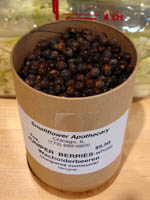 |
|
| First, make sure all of your equipment is well washed and clean to minimize the possibility of contamination as we're depending on natural bacteria in your cabbage to make the sauerkraut
You will need a large bowl to mix the cabbage and a container to hold it as it ages (about a 6 quart container). You'll also need
a way to hold the cabbage down, perhaps some lids that match your container, or even better a matching stackable container. You'll also want some weights to weigh down the cabbage; some clean bottles filled with water work well. This all needs to be very clean.
|
|
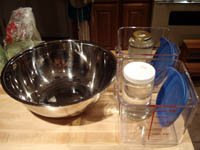 |
|
| 5 pounds of cabbage is about two medium heads, which should be shredded. |
|
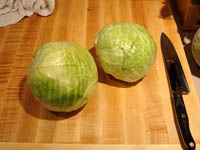 |
|
| I like my sauerkraut thin so I shredded mine as thin as I could using the french method: cut the head in half, then slice along the radius, angling the knife so it's always aimed towards the center of the head. |
|
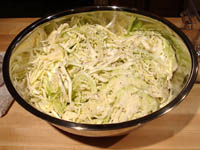 |
|
| Mix in the salt, coriander and juniper berries. You may want to use gloves. If you use your hands, make sure they are very clean to prevent the introduction of strange bacteria. Once mixed, let it sit for 10 minutes or so. |
|
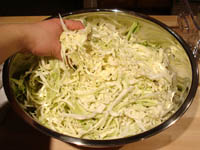 |
|
| Transfer the wilting lettuce into the container and push down to the bottom. Make sure to transfer any liquid that may have come out of the cabbage by now. |
|
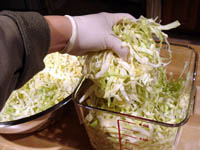 |
|
| Stack the lid or second container on top of the cabbage and weight down with the jars of water. |
|
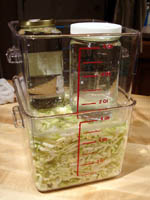 |
|
Here is the cabbage shortly after packing it in the container.
The blue arrow indicates the small amount of water that has come out so far. |
|
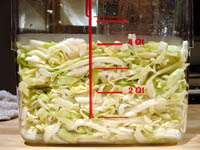 |
|
After 12 hours, the cabbage has wilted more and given off a notable amount of water.
The water line has gone up to the 1 quart line. |
|
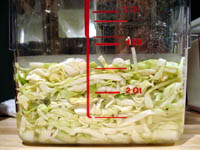 |
|
After 24 hours, the cabbage is almost submerged in the released water.
The water line is up to the 2 quart line. |
|
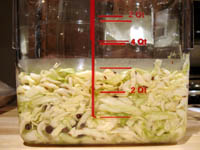 |
|
| After 6 days, the water is up by the 4 quart line and the cabbage is starting to turn a little brown. At this point, it kind of smells like old cabbage, not fresh cabbage and not kraut, but that's ok at this point. Those bubbles at the top are caused by some scum and air that has risen to the top. Every couple days you should skim off the scum and clean the lid/container holding down the cabbage. |
|
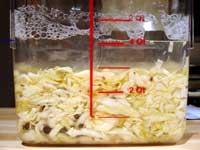 |
|
After 20 days, I actually didn't see much progress and I believe this is because it is winter. Sauerkraut should be kept between 65-70 degrees. Too hot and bad bacteria can grow, too cold and nothing will happen at all, which is what happened to me since my place is only 60 degrees when I'm out of town.
As a result, sauerkraut is proceeding very slowly, but it is starting to smell like sauerkraut and doesn't smell spoiled at all, so that's a good sign.
Sauerkraut is created be a three step fermentation process. Unlike fermentation caused primarily by fungus (i.e. yeast) which creates alcohol and CO2 (e.g. beer, wine and bread), the primary mechanism for sauerkraut is lacto fermentation caused by bacteria that create lactic acid (e.g. yogurt, sourdough, buttermilk and kim chi) that eventually kills off other bacteria. This is also different from acetic fermentation created by bacteria that convert alcohol into acetic acid (e.g. vinegar). |
|
 |
|
For more details on the fermentation process of sauerkraut, check out Wikipedia.
So, after 6 weeks (42 days) there has been little visual change in my sauerkraut but it did smell just like sauerkraut so I went ahead and ate some and so far I'm still here. It tastes like sauerkraut, but a little saltier than I expected and not as sour as I want, but it did make some decent reubens. Maybe it needs more time b/c the cabbage isn't as translucent as I expected either? |
|
 |
|

